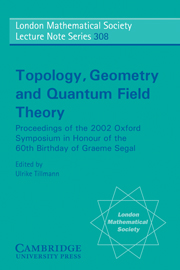 Topology, Geometry and Quantum Field Theory
Topology, Geometry and Quantum Field Theory Book contents
- Frontmatter
- Contents
- Preface
- Participants
- Introduction
- Part I Contributions
- 1 A variant of K-theory: K±
- 2 Two-vector bundles and forms of elliptic cohomology
- 3 Geometric realization of the Segal–Sugawara construction
- 4 Differential isomorphism and equivalence of algebraic varieties
- 5 A polarized view of string topology
- 6 Random matrices and Calabi–Yau geometry
- 7 A survey of the topological properties of symplectomorphism groups
- 8 K-theory from a physical perspective
- 9 Heisenberg groups and algebraic topology
- 10 What is an elliptic object?
- 11 Open and closed string field theory interpreted in classical algebraic topology
- 12 K-theory of the moduli space of bundles on a surface and deformations of the Verlinde algebra
- 13 Cohomology of the stable mapping class group
- 14 Conformal field theory in four and six dimensions
- Part II The definition of conformal field theory
- Foreword and postscript
- The definition of CFT
- References
8 - K-theory from a physical perspective
Published online by Cambridge University Press: 06 November 2009
- Frontmatter
- Contents
- Preface
- Participants
- Introduction
- Part I Contributions
- 1 A variant of K-theory: K±
- 2 Two-vector bundles and forms of elliptic cohomology
- 3 Geometric realization of the Segal–Sugawara construction
- 4 Differential isomorphism and equivalence of algebraic varieties
- 5 A polarized view of string topology
- 6 Random matrices and Calabi–Yau geometry
- 7 A survey of the topological properties of symplectomorphism groups
- 8 K-theory from a physical perspective
- 9 Heisenberg groups and algebraic topology
- 10 What is an elliptic object?
- 11 Open and closed string field theory interpreted in classical algebraic topology
- 12 K-theory of the moduli space of bundles on a surface and deformations of the Verlinde algebra
- 13 Cohomology of the stable mapping class group
- 14 Conformal field theory in four and six dimensions
- Part II The definition of conformal field theory
- Foreword and postscript
- The definition of CFT
- References
Summary
Abstract
This is an expository paper which aims at explaining a physical point of view on the K-theoretic classification of D-branes. We combine ideas of renormalization group flows between boundary conformal field theories, together with spacetime notions such as anomaly cancellation and D-brane instanton effects. We illustrate this point of view by describing the twisted K-theory of the special unitary groups SU(N).
Introduction
This is an expository paper devoted to explaining some aspects of the K-theoretic classification of D-branes. Our aim is to address the topic in ways complementary to the discussions of,. Reviews of the latter approaches include. Our intended audience is the mathematician who is well-versed in conformal field theory and K-theory, and has some interest in the wider universe of (nonconformal) quantum field theories.
Our plan for the paper is to begin in Section 2 by reviewing the relation of D-branes and K-theory at the level of topological field theory. Then in Section 3 we will move on to discuss D-branes in conformal field theory. We will advocate a point of view emphasizing 2-dimensional conformal field theories as elements of a larger space of 2-dimensional quantum field theories. ‘D-branes’ are identified with conformal quantum field theories on 2-dimensional manifolds with boundary. From this vantage, the topological classification of D-branes is the classification of the connected components of the space of 2-dimensional theories on manifolds with boundary which only break conformal invariance through their boundary conditions.
- Type
- Chapter
- Information
- Topology, Geometry and Quantum Field TheoryProceedings of the 2002 Oxford Symposium in Honour of the 60th Birthday of Graeme Segal, pp. 194 - 234Publisher: Cambridge University PressPrint publication year: 2004
- 8
- Cited by


